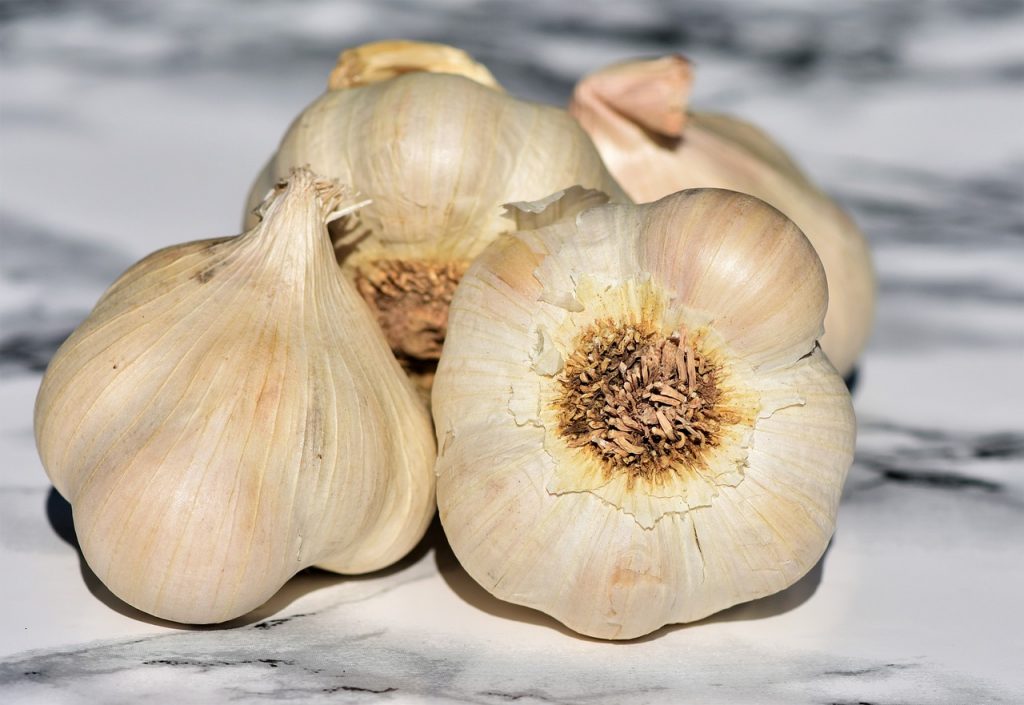Growing Garlic
There are two main categories of garlic. Softneck varieties are the most common. They don’t have a flowerhead and tend to have a longer shelf life. Hardneck varieties have flowerheads like onions, produce fewer, bigger cloves and prefer cooler climates such as ours.
Garlic will also repel aphids and can be used as a companion plant for roses, fruit trees and members of the tomato family.

Site and soil
Garlic likes full sun, good drainage and some well incorporated compost or aged manure.
Planting
In cooler areas, garlic can be planted anytime between late autumn and early spring for best results. Source garlic from an organic provider and steer clear of imported bulbs as they (by necessity) have been fumigated with methyl bromide as they reach Australia.
Separate a bulb into individual cloves – it’s best to source the bulb from an organic provider. Plant each clove pointy end upwards a few centimetres below the soil surface, spaced 10-20 cm apart.
Mulch well as garlic doesn’t like competition from weeds. Regular watering is important and the ground should not be allowed to dry out completely during bulb formation.
Harvesting
Garlic is slow to mature, generally taking around 8 months to produce a bulb. Harvest when the leaves begin to turn brown or yellow – don’t wait until the foliage has completely died back.
Stop watering the plants for at least a week before you intend to harvest. Lift the bulbs carefully from the soil with a fork. If it’s good weather, leave them to dry in the sun for a few days.
Problems
Garlic has few problems with pests or diseases. Thrips can be a problem as can downy mildew and the fungal disease white rot in cool wet weather.
Poor growth may be the result of planting time, watering schedule, soil acidity or variety.
The following update on growing garlic has been provided by Max
Background information
Garlic is one of those that I’d tried several times, with a heap of heirloom varieties (purple, hardneck softneck you name it), and was ALWAYS ticked off by the anaemic results. I’d read all sorts of information but still didn’t do well.
THEN I found a variety of white that the Yarralumla nursery sourced from Murrumbateman. It was going to be my last attempt because clearly I couldn’t grow it. Giant white bulbs in three different sizes and even cheaper than what I’d sourced. I grabbed three giant ones, took them home and after realising the cloves were huge too went back the following week for more. I think all up there were 9 or so bulbs of at least baseball size.
I bought chook poo from the chook farm near the airport (it stank less than the bunnings varieties that had run out plus even cheaper) and also a heap of organic sugar cane mulch (bunnings).
I didn’t know what to expect- the big fat whole garlic I started with were about softball sized with large cloves. I grew even bigger, doing nothing differently. The cloves are very strong, not mild! So I tossed the instructions after that harvest and went with just watch.
It’s now four seasons since then, saving my own and growing organically or handing off to mates. Who cannot believe the size of what I’ve grown vs the supermarket white (or their own growing efforts with non-local varieties).
The flowers look great (agapanthus eat your heart out, plus the bees love them) but I prefer to cut off the scapes and eat them!
If you get them early, like pencil thickness, you won’t blow your head off with the strength of garlic. Eat them like asparagus (microwaved with a little butter, pepper and salt). Leave it too long and the garlic will overwhelm… plus you put your harvest at risk. The bigger the scape the bigger the clove will be- if you cut it off. Yes that seems counter intuitive but the scape will start as a 4 type loop so cut it off after pencil size. The clear sap will be pongy garlic which will help your other plants defend themselves from insects but is hard to remove from hands/clothes. Once it’s straightened up you’ve missed your window- leave it alone for the bees.
Growing notes
It apparently takes a few seasons for garlic to adapt to your area… but who has that kind of time when this means YEARS?
Don’t make life hard for yourself- start with a local grown variety of a type that you can’t find in the supermarket.
Problems/challenges
Forgetting where I’ve planted it- at one point I’d pulled a tiny garlic and tossed it in an area with the rest of the harvest. Or so I thought. Well I didn’t mow for a few months and basically ignored the grass in winter.
Come spring when I mowed again the mower smelled of garlic. Wierd but I mow over lavender and kale and even borage that’s self sown far away from where I wanted it, so I don’t pay any mind these days.
Come harvest season there it was, a giant fat bulb growing at the edge of the (very well mulched) fruit tree bed and lawn.
Nature is truly awesome.
